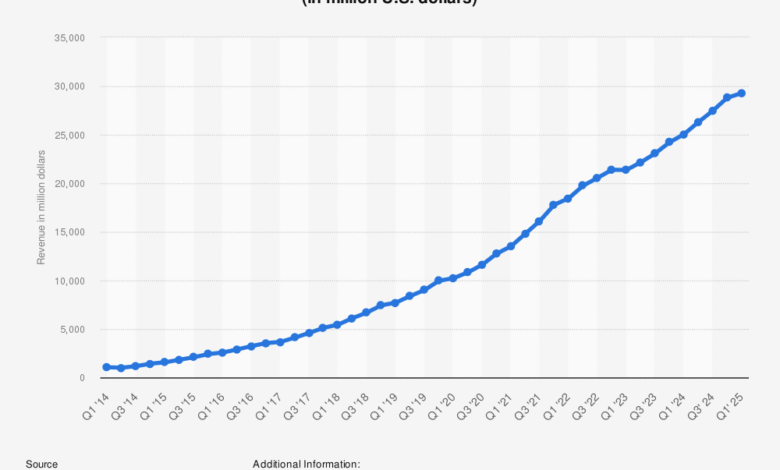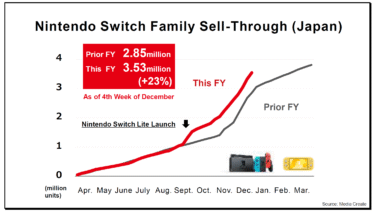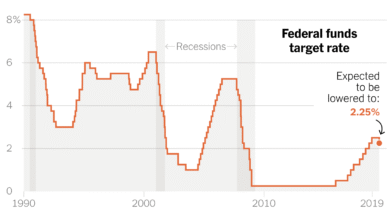Amazon Web Services Growth: Q2 2025 Revenue Surges

Amazon Web Services growth has proven to be remarkable, with the cloud giant reporting an 18% increase in revenue in the second quarter of 2025, bringing in $30.87 billion. This growth highlights AWS’s pivotal role in Amazon’s overall financial ecosystem, contributing 18% to the company’s total revenue and yielding an impressive operating income of $10.2 billion. Despite surpassing analysts’ expectations, this figure fell slightly short of the $10.9 billion forecast, indicating the fierce competition in the cloud market. As AWS moves forward, new contracts, such as the significant multi-year agreement with PepsiCo, reflect its ongoing commitment to expanding its cloud computing revenue through innovative partnerships. Moreover, AWS’s ambitious plans to establish new data centers, including a region in Chile by 2027, signal its strategy to strengthen its global footprint amid escalating cloud market competition.
The expansion of Amazon’s cloud services, known as AWS, continues to be a focal point in the tech industry, showcasing impressive year-over-year performance. In recent reports, it has become clear that AWS plays a vital role in Amazon’s financial strategy, capturing a significant share of the cloud computing landscape. With the introduction of various new contracts and plans for enhanced infrastructure, including state-of-the-art data center developments, AWS is poised to fortify its position against emerging rivals. The escalating rivalry with other key players, such as Microsoft with its Azure platform and Google Cloud, reflects the dynamic nature of cloud services and the relentless pursuit for market leadership. As cloud revenues soar, AWS’s strategy and performance metrics will be essential for analysts and industry watchers alike.
Amazon Web Services Growth: A Beacon in Cloud Computing
Amazon Web Services (AWS) continues to shine as a significant player in the cloud computing market, demonstrating a remarkable 18% year-over-year growth in revenue for the second quarter of 2025. With earnings reaching $30.87 billion, AWS not only meets but slightly surpasses market predictions, emphasizing its dominant position in the increasingly competitive cloud environment. As analysts closely watch AWS’s performance, it becomes essential to recognize how the platform fuels a substantial portion of Amazon’s overall revenue, accounting for 18% of the total and showcasing its importance to the company’s financial health.
Moreover, AWS remains a critical profit center, generating $10.2 billion in operating income for the reported quarter. While this figure fell short of analysts’ expectations, the growth trajectory reflects a continual upward trend. The increasing demand for cloud services also correlates with large-scale enterprise agreements, such as the recent multi-year contract with PepsiCo, which will help the food and beverage giant migrate its workloads to AWS. Thus, AWS’s growth highlights the ongoing shift towards cloud solutions across various sectors, driving sustained profitability and expansive service offerings.
Navigating AWS Contracts to Enhance Cloud Success
Strategic AWS contracts play a pivotal role in expanding cloud computing capabilities for various organizations. The recent multi-year contract signed with PepsiCo is a prime example of how companies leverage AWS’s vast infrastructure to optimize their operational efficiency. By transferring vital workloads to the cloud, PepsiCo not only minimizes latency but also enjoys enhanced scalability and data management. These types of partnerships lend credence to the growth potential within the AWS ecosystem, fostering an environment where businesses can innovate and improve productivity through cloud services.
Furthermore, AWS contracts often unlock advanced services such as machine learning and analytics, allowing companies to harness insights from their data effortlessly. With cloud market competition heating up, securing beneficial contracts with enterprises like PepsiCo can provide AWS with a competitive edge over rivals such as Microsoft and Google. As companies navigate their cloud journey, the efficiency and reliability offered by AWS contracts highlight the critical nature of cloud partnerships in driving success within the broader digital landscape.
Cloud Market Competition: AWS vs. Microsoft and Google
The cloud market is witnessing heightened competition, particularly among major players like Amazon Web Services (AWS), Microsoft Azure, and Google Cloud. In the recent fiscal quarter, Microsoft boasted a staggering 39% growth rate in cloud revenue, generating over $75 billion for the year. This significant increase poses a challenge for AWS, as it enhances Microsoft’s position in cloud computing and solidifies the rivalry between the two giants. As industry momentum shifts, AWS must strategize to maintain its market share against formidable competitors.
Similarly, Google Cloud has reported an impressive 32% increase in revenue year-over-year, highlighting the rapid pace at which the cloud environment is evolving. As these competitors escalate their efforts to capture more clientele through innovative offerings and pricing strategies, AWS is compelled to respond accordingly. The competition in the cloud computing landscape signifies not just a battle for revenue but a race to secure long-term partnerships and diffuse the competitive advantage that AWS has cultivated over the years.
AWS Data Center Plans: A Strategy for Sustained Growth
AWS’s roadmap includes ambitious plans to expand its data center footprint globally, with a notable announcement about establishing a new data center region in Chile by 2027. Such expansions are crucial for sustainably accommodating growing cloud demand while ensuring low-latency access for clients in South America. By investing in infrastructure, AWS aims to bolster its existing service offerings and cater to more customers effectively, thereby solidifying its competitive advantage in the cloud marketplace.
Additionally, the establishment of new data centers is aligned with AWS’s strategy to enhance customer experience and provide reliable services. As businesses increasingly rely on cloud solutions, having local data centers allows for better compliance with regional regulations and provides enhanced data sovereignty. As a result, AWS’s expanded data center plans serve not only to reinforce its market position but also emphasize the long-term vision of supporting its users through robust, scalable, and secure cloud infrastructure.
The Future of Cloud Computing Revenue: AWS in Perspective
The future of cloud computing revenue looks promising, particularly for AWS, which stands at the forefront of this digital transformation. As evidenced by its recent earnings report, the cloud segment has seen substantial growth, contributing significantly to Amazon’s bottom line. Analysts project that as more businesses transition to cloud-based services, AWS is likely to continue benefiting from this movement, ensuring the company remains a leader in the industry ahead of competitors.
Moreover, cloud computing revenue is anticipated to soar as technological advancements and increased digital adoption proliferate. With entities across all sectors striving to modernize their infrastructures, AWS’s innovative solutions and expansive service portfolio position it well for sustained growth. The continued expansion of cloud services will likely enhance AWS’s revenue figures, reinforcing the platform’s fundamental role in shaping the future of digital business operations.
Key Trends Impacting AWS Revenue Growth
Several key trends are significantly impacting AWS revenue growth in today’s rapidly evolving digital landscape. The rise of artificial intelligence (AI) and machine learning applications is prompting organizations to seek scalable cloud solutions that AWS provides. As businesses harness these technologies for improved decision-making, customer engagement, and operational efficiency, the demand for comprehensive AWS offerings continues to increase, driving revenue expansion.
Additionally, the growing trend of hybrid cloud solutions is reshaping how organizations approach their IT strategies. Companies often prefer a mixture of public and private cloud services, allowing them greater flexibility and control. AWS is uniquely positioned to capitalize on this trend by integrating robust hybrid solutions within its service offerings. As organizations look to tailor their cloud environments to fit specific requirements, AWS’s adaptability will likely contribute to ongoing revenue success.
The Importance of Innovation in AWS’s Cloud Strategy
Innovation is a fundamental component of AWS’s cloud strategy, enabling the company to stay ahead of its competitors in the rapidly changing technological landscape. By consistently introducing new features, services, and enhancements, AWS addresses the evolving needs of its diverse clientele, ensuring they can leverage the latest advancements in cloud technology. This focus on innovation is a key driver of AWS’s revenue growth, as companies seek cutting-edge solutions to enhance their operational efficiencies.
Moreover, AWS’s commitment to research and development not only helps reinforce its market position but also instills confidence in clients looking for reliable and future-proof cloud services. By investing in innovative technologies like machine learning, data analytics, and serverless computing, AWS is poised to maintain momentum in cloud revenue growth, offering customers a competitive edge in their respective industries and strengthening the overall ecosystem.
AWS’s Role in the Global Cloud Market Expansion
As a trailblazer in the global cloud market, AWS plays a crucial role in the expansion of cloud services across various sectors worldwide. The company’s aggressive expansion strategies, highlighted by initiatives such as the upcoming data center in Chile, reflect its ambition to cater to the needs of an ever-growing customer base. By localizing its infrastructure, AWS not only enhances performance for clients but also boosts its penetration into emerging markets, essential for driving future growth.
Additionally, AWS’s presence in the global cloud market fosters an environment of competition and innovation. As the demand for cloud services rises, AWS encourages other players in the field to elevate their services and offerings. This competitive spirit fosters an ecosystem where businesses can thrive in digital transformation, creating a cycle of demand for cloud solutions. Thus, AWS’s impact on the global cloud market goes beyond revenue growth; it shapes the future of technology and business operations on a broad scale.
Harnessing the Power of Cloud Analytics at AWS
Cloud analytics has emerged as one of the most significant advantages of utilizing AWS infrastructure, enabling organizations to gain valuable insights from their data rapidly. With services like Amazon Redshift and AWS Glue, businesses can effectively aggregate and analyze vast amounts of data, enhancing decision-making processes. These advanced analytics capabilities empower companies to refine their operations and tailor their strategies to the evolving market landscape, ultimately driving revenue growth.
Furthermore, AWS provides robust tools for machine learning and AI, further enriching its cloud analytics offerings. Organizations leveraging these tools can identify trends and opportunities within their data, allowing them to act swiftly and efficiently. As the reliance on data-driven strategies continues to grow, AWS is well-positioned to be at the forefront of delivering innovative cloud analytics solutions that not only streamline operations but also contribute significantly to overall cloud computing revenue.
Frequently Asked Questions
What factors are driving Amazon Web Services growth in 2025?
The significant growth of Amazon Web Services (AWS) in 2025 can be attributed to increased demand for cloud computing solutions, expansion of services, and strategic contracts with major companies like PepsiCo. With an 18% revenue growth this quarter, AWS continues to dominate the cloud market, showcasing its ability to attract customers looking to migrate workloads to its robust infrastructure.
How does AWS revenue growth compare to competitors in the cloud computing market?
While AWS reported an 18% growth in revenue for Q2 2025, it faces fierce competition from Microsoft and Google. Microsoft’s Azure achieved an impressive quarterly growth rate of 39%, while Google’s cloud services saw a 32% increase in revenue. This competition influences AWS’s growth strategies and market share in the rapidly evolving cloud computing sector.
What role do AWS contracts play in its growth trend?
AWS contracts, such as the recent multi-year agreement with PepsiCo, play a crucial role in its growth by securing long-term relationships with large enterprises. These contracts not only stabilize AWS’s revenue streams but also enhance its reputation as a reliable cloud provider, contributing to overall AWS revenue growth.
What are AWS’s future plans for data center expansion?
AWS plans to establish a new data center region in Chile by 2027, a move designed to enhance its infrastructure and accommodate growing demand for cloud services in South America. This expansion aligns with AWS’s strategy to strengthen its global presence and support continuous revenue growth.
How does the current AWS growth affect its overall contribution to Amazon’s revenue?
As of Q2 2025, AWS accounts for 18% of Amazon’s overall revenue, reflecting its pivotal role as a profit generator for the company. Despite slightly missing analysts’ estimates in operating income, AWS’s growth continues to significantly contribute to Amazon’s financial success and stability in the competitive cloud market.
| Key Metrics | Amazon Web Services (AWS) Analysis |
|---|---|
| Q2 2025 Growth in Revenue | 18% growth, $30.87 billion in revenue, surpassing expectations of $30.8 billion. |
| AWS Contribution to Revenue | AWS accounts for 18% of Amazon’s overall revenue. |
| Operating Income | Earned $10.2 billion in operating income, below analysts’ estimate of $10.9 billion. |
| New Agreements | Multi-year contract with PepsiCo to transfer workloads to AWS. |
| Upcoming Developments | A new data center region to be established in Chile by 2027. |
| Competitive Landscape | Facing increasing competition from Microsoft Azure and Google Cloud services. |
| Competitors’ Growth Rates | Microsoft Azure: 39% growth, $75 billion in revenue for fiscal year ending June 30. |
| Competitive Growth Comparison | Google Cloud: 32% year-over-year increase, totaling $13.62 billion. |
Summary
Amazon Web Services growth is a significant factor contributing to Amazon’s overall performance, marked by an 18% revenue increase in Q2 2025. Despite slightly missing analysts’ expectations in operating income, AWS remains a crucial profit driver, accounting for a sizable portion of Amazon’s sales. The announcement of new contracts and plans for a data center region in Chile indicate AWS’s commitment to expanding its market presence. However, the fierce competition from Microsoft and Google Cloud services poses a challenge, as these competitors are achieving faster growth rates. Moving forward, AWS will need to innovate and enhance its services to maintain its position in the rapidly evolving cloud market.




